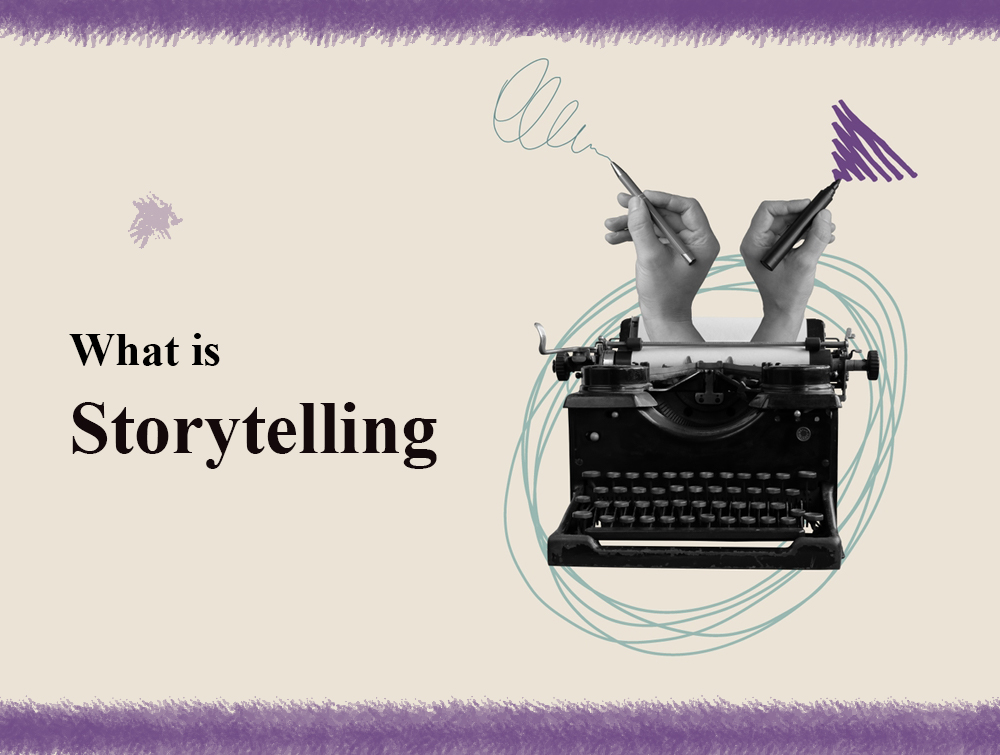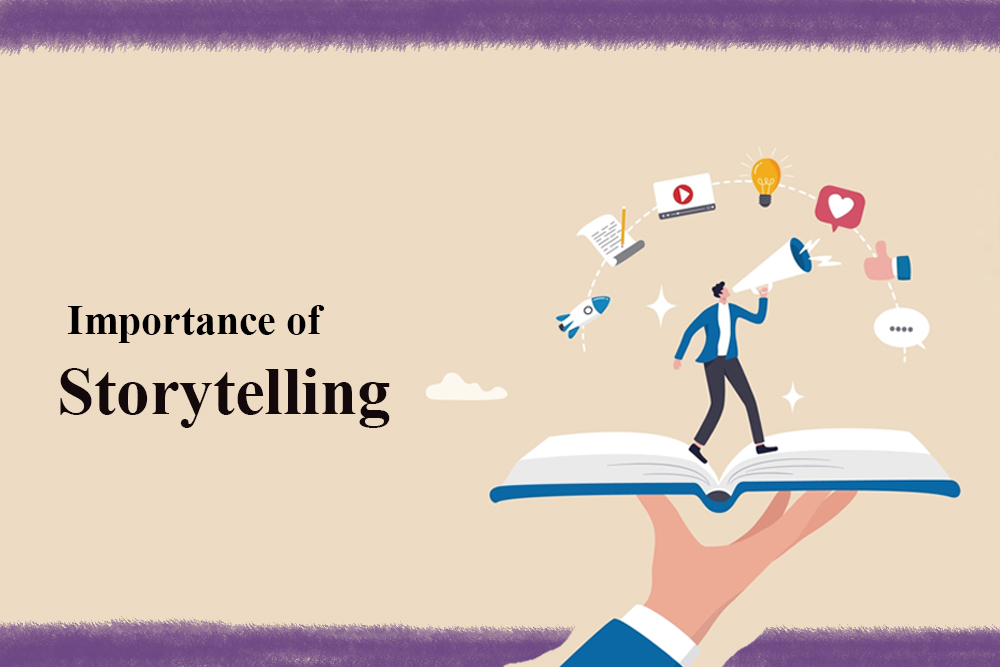Introduction:
In a world of constant distractions and short attention spans, storytelling remains a timeless and powerful art. But what makes storytelling so essential in today’s digital age? Let’s embark on a journey to discover the magic of storytelling and its secrets to crafting compelling content.
What is Storytelling?

At its core, storytelling is the art of conveying a message or idea using narrative techniques such as characters, plot, and setting. It’s the act of weaving together words, emotions, and experiences to engage and connect with an audience on a deeper level. Whether told through words, images, or sounds, stories have the power to evoke emotions, inspire action, and leave a lasting impression on those who experience them.
The Importance of Storytelling:

Now, you may be wondering, why is storytelling so important in today’s fast-paced digital landscape? The answer lies in its ability to humanize brands, forge meaningful connections, and cut through the noise of endless content for our attention. In a world overloaded with advertisements, emails, and social media posts, storytelling allows brands to stand out by creating authentic, memorable experiences that resonate with their audience.
Moreover, storytelling transcends cultural and linguistic barriers, making it a universal language that speaks to the hearts and minds of people from all walks of life. Whether you’re a business looking to connect with customers, a nonprofit seeking to raise awareness for a cause, or an individual sharing your personal journey, storytelling is the key to making your message heard and remembered.
Why You Must Use Storytelling:
Now that we understand the essence of storytelling, let me share with you why it’s not just a nice-to-have but a must-have in your content strategy. Firstly, storytelling builds trust and credibility by allowing brands to share their values, beliefs, and unique perspectives authentically. By showcasing the human side of your brand, you create an emotional connection with your audience, fostering loyalty and long-term relationships.
Secondly, storytelling is inherently memorable. Research carried out by Cognitive Psychologist ‘Jerome Bruner’ suggests that we are 22 times more likely to remember information presented in the form of a story than through facts and figures alone. By crafting narratives that resonate with your audience’s experiences and aspirations, you ensure that your message sticks in their minds long after they’ve encountered it.
Lastly, storytelling has the power to inspire action. Whether it’s prompting a purchase, encouraging a donation, or inciting social change, stories can move people to take meaningful action. By tapping into the emotions of your audience and painting a vivid picture of the desired outcome, you can motivate them to join you on your journey and become active participants in your story.
With storytelling, the possibilities are endless, and the adventure awaits. Are you ready to tell your story?
Person A: Storytelling Approach
Imagine Person A, a marketer for a skincare brand, begins their pitch by sharing a personal anecdote about their struggles with acne during their teenage years. They vividly describe the embarrassment and frustration they felt, trying countless products without success. Then, they narrate the transformative moment when they discovered the brand’s flagship product. They paint a picture of how their skin cleared up, boosting their confidence and changing their life.
As Person A continues to weave its story, it seamlessly integrates key features and benefits of the skincare product. They explain how the product’s unique formula helped address their specific skin concerns and emphasize its effectiveness through their own experience. By the time they transition to the sales pitch, the audience is fully invested in the story and eager to learn more about the product that made such a difference in Person A’s life.
Audience Behavior:
The audience listening to Person A’s storytelling approach is captivated from the start. They feel a sense of connection and empathy with Person A’s personal journey, making them more receptive to the product being promoted. As a result, they are more likely to engage with the sales pitch, ask questions, and ultimately consider purchasing the skincare product. The emotional resonance of the story leaves a lasting impression on the audience, driving higher levels of interest and brand loyalty.
Person B: Direct Sales Approach
In contrast, Person B, another marketer for a skincare brand, adopts a direct sales approach without storytelling. They dive straight into listing the features and benefits of the skincare product, highlighting its ingredients, clinical studies, and customer reviews. While Person B provides valuable information about the product, their pitch lacks the emotional depth and personal connection present in Person A’s storytelling approach.
Audience Behavior:
The audience listening to Person B’s direct sales approach may feel overwhelmed by the barrage of information presented to them. Without the context of a personal story, they struggle to relate to the product on a deeper level. As a result, they are less engaged and more likely to tune out or dismiss the sales pitch altogether. While some audience members may still express interest in the product based on its merits, the overall impact is diminished compared to Person A’s storytelling approach.
Comparison:
Person A’s storytelling approach effectively engages the audience on an emotional level, fostering a sense of connection and trust. By sharing a personal story, Person A creates a narrative that resonates with the audience’s own experiences and struggles, making the product more relatable and compelling. In contrast, Person B’s direct sales approach, while informative, lacks the emotional resonance and storytelling elements that capture the audience’s attention and drive engagement.
Overall, Person A’s storytelling approach proves to be more effective in connecting with the audience and influencing their behavior compared to Person B’s straightforward sales pitch.
Absolutely! Let’s make storytelling practical and actionable, keeping it readable and SEO-friendly:
Storytelling is the craft of sharing information through engaging narratives. It’s like taking your audience on an adventure, using words to paint vivid pictures and evoke emotions.
Picture this: You’re at a cozy café, chatting with friends. Instead of bombarding them with facts, you share a personal story about overcoming a challenge at work. As you speak, they lean in, eager to hear how it all unfolded.
That’s the magic of storytelling. It’s relatable, it’s memorable, and it cuts through the clutter of everyday conversations.
How can you harness the power of storytelling in your own life?
1. Know Your Audience: Understand who you’re speaking to and what matters to them. Tailor your story to resonate with their interests and experiences.
2. Keep it Simple: Use clear and concise language that everyone can understand. Avoid jargon or complex terminology that might confuse your audience.
3. Start with a Hook: Grab your audience’s attention from the start with an intriguing opening line or an unexpected twist. This sets the stage for the rest of your story.
4. Create Characters: Whether it’s a protagonist overcoming obstacles or a group of friends embarking on a journey, characters add depth and personality to your story.
5. Build Tension: Keep your audience on the edge of their seats by introducing conflicts or challenges that need to be resolved.
6. Show, Don’t Tell: Instead of just stating facts, use descriptive language and sensory details to immerse your audience in the story. Let them see, hear, and feel what’s happening.
7. Include a Lesson or Message: Every story should have a takeaway – whether it’s a moral lesson, a piece of advice, or a call to action. Make sure your audience walks away with something meaningful.
8. Practice, Practice, Practice: Like any skill, storytelling takes practice. Experiment with different techniques, solicit feedback and refine your storytelling abilities over time.
By incorporating storytelling into your communications, whether it’s in presentations, blog posts, or social media updates, you can create more engaging and memorable experiences for your audience. And in today’s digital landscape, where attention is a scarce commodity, that’s a powerful advantage.
So, go ahead – unleash your inner storyteller and watch as your messages come to life in the hearts and minds of your audience.
This practical guide to storytelling emphasizes actionable tips that anyone can implement to enhance their communication skills and connect more deeply with their audience.
Conclusion:
In conclusion, storytelling is not just a tool for communication but a powerful force that can transform hearts, minds, and behaviors. By harnessing the art of storytelling, you can breathe life into your content, forge deeper connections with your audience, and leave a lasting impact that transcends time and space. So, dear readers, I invite you to embark on your storytelling journey and unlock the magic that lies within. And if you’re eager to learn more about the secrets of storytelling, be sure to check out my previous post, “Top Secrets Revealed,” where I delve deeper into this timeless art form.
share your own storytelling experiences or insights in the comments section.










